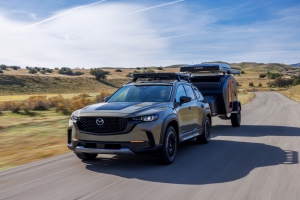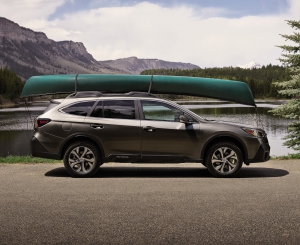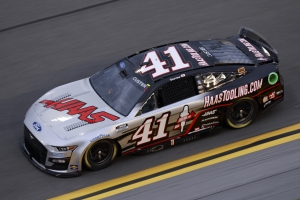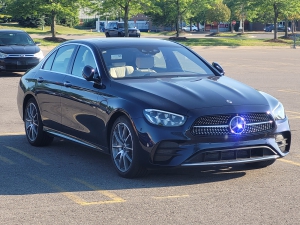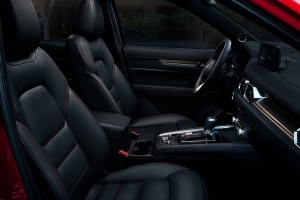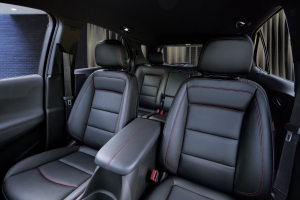
Matt M. Myftiu
Matt Myftiu has been a journalist for two decades with a focus on technology, NASCAR and autos.
Brittany Force, Erica Enders claim NHRA titles for Team Chevy
Brittany Force put a big Bowtie stamp on the NHRA Camping World Drag Racing Series season in the Auto Club NHRA Finals.
Force, driving the Monster Energy/Flav-R-Pac Chevrolet dragster, earned her second Top Fuel world championship in the season finale at Auto Club Raceway at Pomona to become the fourth female in NHRA professional ranks to win multiple titles.
"I want people to remember this day here in Pomona with this Monster Energy/Flav-R-Pac team -- David Grubnic, Mac Savage, every single one of my guys," said Force, who also joined three-time champion Shirley Muldowney as the only female multiple titleholders in Top Fuel. "We have been working all season long, we never gave up, and then we struggled in the Countdown and we recovered when we needed to in Vegas and win it here today in Pomona.
“I have to thank every single one of my guys and our sponsors. We wouldn't be here without them today, and I'm just so proud of everybody. It just seems surreal right now. I can't believe it ended up this way.”
2023 Mazda CX-50 debuts with bold looks, thrilling drive
As the reinvention of their SUV lineup continues, Mazda continues to introduce impressive new models.
The latest is the 2023 Mazda CX-50, a compact crossover that will battle with leading competitors in the segment including the Nissan Rogue, Toyota RAV4, Honda CR-V, and Ford Escape.
And just to clarify, the CX-50 is different from the already existing CX-5, another compact crossover currently in the Mazda lineup (which may or may not continue to coexist in coming years). The CX-50 shares a platform with the smaller CX-30, and upcoming models in the pipeline that are anticipated include the larger CX-70 and CX-90.
While the introduction of these new vehicles brings in some new designs, what doesn’t change is the quality of what’s under the hood, and that’s the excellent Mazda power plants that made this brand stand out in a bevy of SUV competitors, especially for driving enthusiasts who want to enjoy their daily drive.
I recently tested a 2023 Mazda CX-50, and I’m back with a full report on how the new offering measures up to Mazda’s lofty standards.
2022 Subaru Forester Wilderness strong on tech, comfort, off-road ability
If you’re looking for a compact SUV these days, there is no shortage of options to consider. So to stand out, automakers must take new approaches.
On that note, let me introduce the 2022 Subaru Forester, and its new Wilderness edition — a vehicle that definitely stands out among its competitors.
This all-wheel drive, 5-passenger vehicle with impressive ground clearance can operate confidently on city streets, but also step up when some light off-roading or rough weather presents itself. For the outdoorsy type of person, it serves as a welcome alternative to the usual suburban family ride, while keeping many of the qualities from those vehicles such as strong tech and safety features.
The WIlderness trim, new for 2022, comes with a redesigned bumper, grille and headlights, plus roof rails that can support more weight.
I recently spent some time behind the wheel of a 2022 Subaru Forester Wilderness, and I’m back with a full report.
2022 Subaru Outback wagon adds off-road friendly Wilderness model
The wagon is a staple of American car culture.
And even if we don’t use the term much anymore in a world focused on SUVs and crossovers, the fact is they do still exist and are available from a small number of automakers in 2022.
The most obvious example of a wagon that people still take out on the roadways every day is the Subaru Outback, which has for years been the dominant vehicle in the segment — accounting for the vast majority of wagon sales in the U.S. each year..
This long, spacious ride might not look exactly like the wood-paneled vehicles of your childhood, but it serves the same purpose — hauling the family and a bunch of cargo with ease.
With its rugged looks and design, and the introduction of a more off-road friendly Wilderness model for 2022, the Outback continues to work on expanding its foothold in this segment. Combine all that with a truly versatile interior, and the Outback is a vehicle that probably should be even more popular than it is.
I recently spent some time in a 2022 Outback Wilderness, and I’m back with a full report.
Cole Custer penalty undeserved; What’s next for Kurt Busch?; Toyota’s talent pipeline woes
Teammates help each other out.
It’s part of racing, and always has been.
When Jeff Gordon was trying to wrap up his first title back in the 1990s, Rick Hendrick would enter an extra car in the race just so it could drop out and guarantee Gordon another spot. When stages are about to end, drivers often don’t lap their teammates even if they are able to do so, out of respect for their overall team goals. Every team on the grid, from Hendrick to Gibbs to SHR and beyond, has told its drivers to support their teammates in one way or another, often explicitly on the radio.
So the decision to punish Cole Custer and the 41 team for alleged improper action to help teammate Chase Briscoe at the end of the Roval race is quite dishonest in my view. This wasn’t a Clint Bowyer itchy arm situation and there was no blatant manipulation. Briscoe was going to dive bomb into that corner regardless of what Custer did, and likely make the pass anyway, so overanalyzing the 41 car’s actions is unnecessary.
What’s most bothersome is the inconsistency. In recent years, Chase Elliott did a playoff favor for Kyle Larson by holding up Kevin Harvick, and Erik Jones was told explicitly to not pass teammate Denny Hamlin. But nobody was punished in those instances.
Let’s not get into the habit of over-policing, which is the complete opposite of “boys, have at it” and not the direction we need to go in as a sport.
2022 Mercedes-Benz E-class is a smooth, powerful, high-tech luxury sedan
Competition is tough in the luxury sedan world these days — with stout offerings available from upstarts like Genesis as well as long-standing segment leaders such as Audi and BMW.
One brand that always puts up a good fight in this arena is Mercedes-Benz, and their midsize sedan offering, the E-class, should never be left out of the discussion of top luxury rides.
The E-class slots between Mercedes’ smaller C-class and larger S-class. WIth a history of offering sharp looks inside and out, a powerful and smooth ride, as well as leading tech and safety options, it has a strong past to live up to.
The 2022 E-class model sees some minor upgrades in terms of features offered, as well as some new paint schemes — but it’s core competencies remain strong. It’s a sporty ride masquerading as a family sedan, featuring exquisite design and powerful performance.
The 2022 E-class is available as a sedan, coupe, convertible or wagon. I recently spent some time behind the week of a 2022 Mercedes-Benz E450 sedan, and I’m back with a full report on how it measures up vs. its luxury competition.
2022 Mercedes-Benz GLS is a stout, three-row luxury land barge
Mercedes-Benz is one of the leading contenders across the board in the luxury vehicle category, and one area where the luxury brands are battling for supremacy is in the flagship three-row SUV category.
The Benz offering here is the GLS class — which goes head-to-head with U.S. stalwarts like the Cadillac Escalade and Lincoln Navigator, as well as global SUV offerings from BMW, Audi, Infiniti, Lexus and Range Rover.
A three-row luxury SUV with comfortable seating for seven people, the GLS pulls out all the stops in a bid for category supremacy. But is it enough?
I recently spent some time in a 2022 GLS 450, and I’m back with a full report.
2022 Mazda CX-5 is a classy, sporty compact SUV
When it comes to sporty compact SUVs, Mazda has no shortage of offerings for potential customers — all providing the rare SUV combination of driving enjoyment and vehicle utility.
In addition to their long-standing CX-5, Mazda recently introduced the CX-50 — a more off-road inspired offering with higher ground clearance.
For the 2022 CX-5, Mazda has made all-wheel drive standard, improved engine options, made minor exterior design changes, and also upgraded the suspension.
I recently tested out the 2022 CX-5, and I’m back with a full report on how it measures up to its competition both outside and inside the Mazda lineup.
2022 Toyota Tundra delivers with bold redesign, new tech offerings
Fifteen years is an eternity in the automotive industry.
But before the release of the 2022 Toyota Tundra, that’s how long it had been since the brand’s biggest truck had gotten a new look. With as much innovation as its competitors have seen in the years since, this move was long overdue.
Packing some strong tech upgrades, new power plant options including a hybrid offering, and an exciting new look, the 2022 Tundra is sure to bring a spark into Toyota’s efforts to grow in the full-size truck segment as it takes on the Detroit Three’s heavyweight contenders.
I recently spent some time in the redesigned Tundra and I'm back with a full report.
2022 Chevy Equinox offers smooth ride, strong tech; adds RS trim level
Compact SUVs are one of the most reliably successful sellers in today’s automotive ecosystem, putting up some of the biggest overall numbers once you get past the top-selling trucks.
Chevy’s Equinox competes in this tough segment — battling a bevy of competitors including the Nissan Rogue, Honda CR-V, Toyota RAV4 and Ford Escape.
For those buyers who remain loyal to the U.S. “Big Three” options, the Equinox emerges as one of the top competitors in the segment. While not completely redesigned, the 2022 Equinox does get some minor refreshes and offers a bold new RS trim level.
I recently spent some time behind the wheel of a 2022 Equinox RS, and I’m back with a full report on how it holds up in the segment.
News Categories
Popular Tags
Search Reviews by Make

AutoTechReviews is your home for In-depth reviews of the latest cars, trucks, and SUVs; information on all the emerging vehicle technology; and breaking news from the world of NASCAR and other motorsports.

